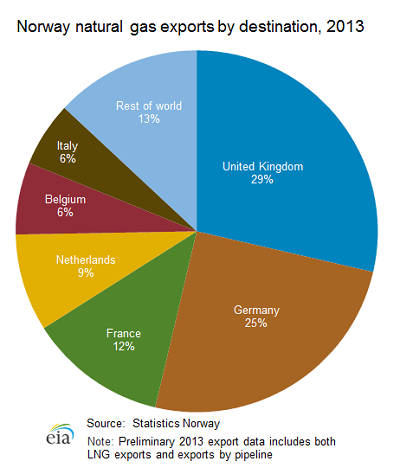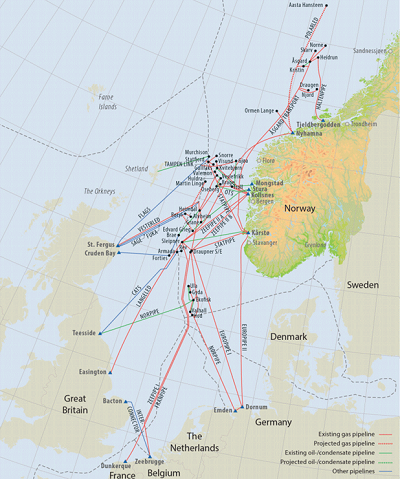Norway Maintains High Gas Exporter Status
Norway is the world's third-largest exporter of natural gas after Russia and Qatar. According to OGJ, Norway had 74 trillion cubic feet (Tcf) of proven natural gas reserves as of January 1, 2014. Despite maturing major natural gas fields in the North Sea, Norway has been able to sustain increases nearly every year in total natural gas production since 1993 by continuing to develop new fields.
Statoil dominates natural gas production in Norway, but a number of international oil and gas companies, including ExxonMobil, ConocoPhillips, Total, Shell, and Eni, have a sizable presence in the natural gas and oil sectors in partnership with Statoil. State-owned Gassco is responsible for administering the natural gas pipeline network. The company also manages Gassled, the network of international pipelines and receiving terminals that exports Norway's natural gas production to the United Kingdom and continental Europe.
 Norway's largest producing natural gas field is Troll, which according to estimates from the NPD produced 1.05 Tcf in 2013, representing about 27 per cent of Norway's total natural gas production that year. The three other largest producing fields in 2013 were Ormen Lange (0.76 Tcf), Asgard (0.34 Tcf), and Kvitebjorn (0.24 Tcf). These four fields accounted for just over 60 per cent of Norway's total dry natural gas production in 2013.
Norway's largest producing natural gas field is Troll, which according to estimates from the NPD produced 1.05 Tcf in 2013, representing about 27 per cent of Norway's total natural gas production that year. The three other largest producing fields in 2013 were Ormen Lange (0.76 Tcf), Asgard (0.34 Tcf), and Kvitebjorn (0.24 Tcf). These four fields accounted for just over 60 per cent of Norway's total dry natural gas production in 2013.
The Gjoa oil and gas field, developed by Statoil and GDF Suez, began production in January 2011. Located in the North Sea, Gjoa is estimated to have produced 24,000 bbl/d of oil and 0.10 Tcf in 2013. The gas is transported directly via pipeline to St. Fergus, Scotland. The oil is transported to the Mongstad refinery through the Troll II pipeline. Aker Solutions, an oil services company headquartered in Norway, constructed a floating production platform for the Gjoa field. For the first time in the offshore oil and gas industry, the floating platform is fully powered by electricity from the mainland using a 60-mile long subsea cable. The Gjoa platform opens a new area in the North Sea for production, and its infrastructure will be a hub for future developments.
Statoil was a partner with Total in Gazprom's development of the Shtokman natural gas and condensate field in the Barents Sea, 342 miles offshore Russia. Reserves have been estimated at nearly 140 Tcf. Phase 1 of field development is projected to provide annual production of 837 Bcf per year (Bcf/y). However, in 2012, Phase I of the project was indefinitely delayed largely because of technical and cost challenges. Soon after that announcement, Statoil sold its stake in the project back to Gazprom. No further announcements have been made about plans to develop the Shtokman field in the near future.
The US Energy Information Administration (EIA) estimates that Norway exported an estimated 3.8 Tcf of natural gas in 2013, 96 per cent of its production. Most of the natural gas was transported to other European countries via its extensive export pipeline infrastructure, and a small fraction was exported via LNG tanker. Norway is the second largest supplier of natural gas to the EU, behind Russia, supplying about 21 per cent of Europe's total gas demand in 2013. According to preliminary data from Statistics Norway, the largest importers of Norway's natural gas exports, as of 2013, were the United Kingdom, Germany, France, the Netherlands, Belgium, and Italy.
Norway operates several important natural gas pipelines that connect directly with other European countries, specifically France, the United Kingdom, Belgium, and Germany:
Franpipe, with a capacity of 709 Bcf/y, exports gas to Dunkirk, France.
Zeepipe I, IIA, and IIB have a total capacity of 2,435 Bcf/y and transport gas to Zeebrugge, Belgium.
Europipe I and II, with a total capacity of 1,507 Bcf/y, export to Dornum, Germany.
Norpipe, with a total capacity of 412 Bcf/y, runs to Emden, Germany.
Vesterled, capacity 502 Bcf/y, links to St. Fergus, Scotland.
Langeled, capacity 928 Bcf/y, links to Easington on the east coast of England.
 These pipelines are all operated by Gassco. Some pipelines run directly from Norway's major North Sea production facilities to Gassco-owned processing facilities in the receiving country. Other pipelines connect Norway's onshore processing facilities to other European markets.
These pipelines are all operated by Gassco. Some pipelines run directly from Norway's major North Sea production facilities to Gassco-owned processing facilities in the receiving country. Other pipelines connect Norway's onshore processing facilities to other European markets.
According to the Norwegian Petroleum Directorate (NPD) and BP Statistical Review of World Energy 2013, shipments of Norwegian LNG in 2012 totaled 166 Bcf, up from 150 Bcf in 2011. European and Eurasian countries in 2012 received about 65 per cent of Norway's LNG exports, most of which were exported to Spain.
Norway became an LNG exporter in 2007 with the beginning of commercial production from the Snohvit gas field, Norway's first natural gas development in the Barents Sea. Statoil operates an LNG export terminal and liquefaction facility at Melkoya, near Hammerfest. The Melkoya facility, the first large-scale LNG export terminal in Europe, has a capacity of about 200 Bcf/y and is connected by pipeline with the Snohvit gas field. The Snohvit field is estimated to have produced 0.15 Tcf in 2013. The Melkoya facility is producing at full capacity, and Statoil was considering expanding the export capacity at the facility. However, in late 2012, Statoil announced that its partners would not continue work on a capacity increase at the Melkoya facility because gas discoveries at that point did not warrant further expansion. Instead, the focus will be on upgrading the existing LNG terminal at the Melkoya facility.
